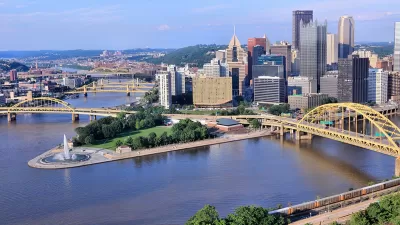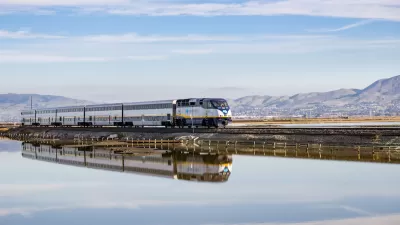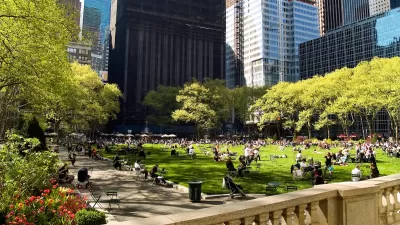Planetizen Managing Editor James Brasuell recently gave the Pitkin Lecture at the Pennsylvania state chapter of the American Planning Association's annual conference. An adapted and excerpted version of that lecture follows.

Earlier this month, on October 12, in fact, Philadelphia Inquirer Architecture Critic and Pulitzer Prize winner Inga Saffron wrote some of the most unequivocal words of support for planning that I have ever encountered from a non-practitioner.
In describing the push for open streets events in Philadelphia, following the accidental example created by Pope Frances' visit to the city, Saffron writes: "Urban planners are starting to pile up the wins. They've introduced amenities that encourage the slow-movers - things like sidewalk cafes, parklets, bike lanes, and riverfront trails." But here's the key soundbite: "It's no accident that the emphasis on people-friendly attractions has coincided with the greatest urban revival since American cities crashed in the 1960s."
When I read this sentence, my jaw dropped. Did she just give full credit to planning—and planners—with success in improving her city and other cities like it? There is no subtext here about privilege and gentrification, or some snide aside about how some dedicated citizens made these things happen in spite of planners. But there's nary a caveat to be found. Isn't that a breath of fresh air?
I agree with Ms. Saffron: there are no coincidences when it comes to planning's role in shaping the built environment as we find it today. But it's also no coincidence that planning has begun experimenting with new practices and models just when the inadequacies of the old practices and models became apparent.
The effects of planning have never been so conspicuous in the public consciousness. Think of how common it is to see discussion about housing, sustainability, or transportation in non-planning circles. As our country and our communities have grown, more and more people are involved in the challenging and fraught process of reevaluating our collective and individual quality of life, our economic and social mobility, and our continued access to the freedoms upon which this country was established.
The stature of planning in contemporary times is evidenced by publications like the Pittsburgh Post-Gazette, the Washington Post, and the New York Times finding new, interactive ways to tell the stories of the built environments, but also with the growing popularity of publications like CityLab, NextCity, Curbed, Streetsblog, and, yes, Planetizen—these are, in some cases, household names with incredible power to inform and sway public opinion.
Yet, the challenges facing the contemporary practice of planning exist persist despite, and maybe occasionally because of, the growing public awareness of the concepts of planning. Certainly these are difficult, far-reaching challenges, and the obstacles in the way of making our aspirations for the field a reality can come from surprising sources and in surprising forms. With so much attention trained on the critical issues of planning, planners and their partners must do a better job of identifying opportunities for planning to produce results, for those results to benefit a larger, more diverse number of people, and to do a better job of telling the story of those successes. To sum it up, we must do a better job telling the story of planning.
>>>>
The era of Google has only made it more difficult to define "planning." Would you really expect someone to enter the word planning in Google and find something in the realm of Jane Jacobs, Robert Moses, or for that matter, Ray Gastil?
I have often wondered, in a slightly masochistic form of humor, how many of Planetizen's visitors are actually wayward party planners, more interested in building a balloon arch than how to craft a zoning code that accomplishes the goals of the city's comprehensive plan.
I wondered so much that I wrote am April Fool's Post that falsely reports that Matthew McConaghey will star in a new movie called The Urban Planner. It's now one of the most popular stories of the year on Planetizen, and it's a fake story. It's all because I thought The Wedding Planner, starring Matthew McConaghey at a much less critically acclaimed period in his career alongside Jennifer Lopez, reflects the universally accepted meaning of the word planning.
To plan is a verb that applies to many different parts of life—maybe even all parts of life, if you're that kind of person. To make matters worse, the word planning is often most descriptive in its absence—as in "This wedding is going to be a disaster because I am horrible at planning" or "Our lives together will be an adventure because we both hate to plan."
Our planning is something different—something widely misunderstood and underappreciated, but something fundamental, something productive, and something visionary.
But what is it—is it planning? Is it urban planning? Is it regional planning? Is it community planning? What about site planning, master planning, or environmental planning? How many times have you said you are a planner, only to have to follow up with one of those terms to make yourself understood? And how many times is that where the conversation ended?
I encounter "urban" as the most common "explainer" text used to modify the word planning. I bristle every time I hear it used, without thought, as a shorthand to describe the field of planning.
How many planners living in rural or suburban communities feel that the title of urban planner fails to accurately describe their intentions or their accomplishments? Defaulting to the use of "urban" before planning implies a failure of the language we have adopted to describe the field of planning.
When we use urban planning as a universal term, we ignore many other types of communities. We even imply that planning will only seek urban inspirations for its prescriptions and its policies. Isn't that troubling—the idea that planning only works one way? Isn't it also troubling that we would imply the idea that communities only work one way?
We shouldn't rest until the revitalization described by Inga Saffron in that article quoted earlier is available to communities of all sizes, shapes, geographic locations, and political proclivities. Don't let planning be reduced to urbanism, urban design, or urban planning. Find places for planning to be successful in rural communities, suburban communities, and at the regional and national scale. Not because urban is a dirty word, but because it's not the only word.
>>>>
Our country is full of great cities, communities, towns, neighborhoods, and places. Pittsburgh is a truly breathtaking example. As a Californian I am envious of Pittsburgh's long history on the banks of flowing rivers, surrounded by trails and so many beautiful trees.
But some of those great places were built since the end of the last world war, and some of them were even built in California.
Regardless of whether they date to the 17th century or the 20th century, we must keep working to protect and improve these communities, even as we allow them to change. And we have to keep working to find new ways to build healthy and prosperous communities in the 21st century, and centuries to come.
In fact, none those things—protecting, improving, or building—are possible without planners.
But a prosperous and healthy future will require planners to do more and do better than they have done. If planners can commit to improving their practices—they'll not only set an example for other professions and communities to do the same, but they'll also simultaneously provide other professions and communities with the resources and infrastructure to do so. How many professions get such an opportunity to benefit so many people?
To do so, I propose a simple starting point for a new era of planning.
Planners—working together with the media—must do a better job of telling the story of planning. I know that doesn’t sound simple. What's simple about density bonuses, conditional use permits, or environmental review processes? That's why I think we should start with more fundamental concepts, like land, home, water, air, and economy.
Such an education does not need to be paternalistic—but it can and should be a process of learning and discovery. Everyone, even the most expert planner, has more to learn more about the cities and towns were we work and live. When we talk about planning, we should always be talking about a process of discovery. And planners should always participate—sometimes as a leader and sometimes as a follower—in that discovery process.
When people working together discover what makes places great, they probably won't be talking about pro-formas, grants, and administrative approval. They'll probably be talking about land use, materials, access, and mobility. The first step is to give people the concepts that help them better understand the places they love, and what they love about them.
My colleague Bill Fulton, publisher of the California Planning and Development Report, director of the Kinder Institute for Urban Research, and former mayor of the city of Ventura in California, calls the passion for understanding the built and natural environments the "place gene." Some people have it; some haven't realized they have it; some might never have it.
I think it would be safe to bet that planners reading this right now have it. Planning is the best field for people like us, isn't it?
Certainly planners do not have a monopoly on this gene. Professionals and citizens of all kinds have the place gene, and I believe that to increase the power of planning, planners must seek out those other people with the place gene and find new ways to partner.
Planners must make a case for themselves as partners in the process of protecting, improving, and building communities. Words like city, urban, or regional to explain might still be necessary to explain what and how planners do their work, but partner should be the next word.
Luckily partnering is something planners already do all the time—with architects, landscape architects, traffic engineers, politicians, and citizens. And in recent years, planners have been actively expanding those partnerships, with public health professionals, environmentalists, bike and pedestrian advocates, and a more diverse collection of communities and interests.
None of these groups of professionals and citizens can achieve their goals for both public and private interests without the help of planners. Planning is partnering.
>>>>
One of the ways planners are most essential as partners is in their roles as researchers. Planners provide this service in a number of ways. First, as founts of knowledge about the layers of legislation and codes that have shaped the communities we live in now.
There are reports that the complete Zoning Code for the city of Los Angeles takes up a large bookcase covering an entire wall of a room hidden in the bowels of City Hall. I don't fault anyone working in Los Angeles City Hall right now for allowing such an arcane and inaccessible archive to retain such tremendous and far-reaching influence over the shape of city—both now and in the future. This is the zoning code we inherited, and there are also reports that a lot of very bright planners and citizens are working very hard to simplify and digitalize that code.
But put simply, a functioning city has to access its zoning code, and its many other land uses regulations. And planners are the most prepared to dive into those archives and retrieve relevant and valuable information.
There's another perspective on the value of the research already being performed by planners. The histories of cities and places can't be written without the insights offered by the record of planning and land use regulation. The work of websites like Market Urbanism, which often reports deep insight into the development history of New York, and the work of the USC Library in Los Angeles, which shares historic photos of how the City of Angels looked at various points in its history, are great examples of the power of planning history to offer perspective about the present. One of the benefits of the growing interest in urban areas in recent years, I think, has been an outpouring of historic photographs, documents, and more. The demand for historical evidence is as great as it has ever been.
Another local publication in Los Angeles, KCET, which is an independent public television station and website, for a long time published a feature called "The Laws that Shaped L.A." online. There, tens of thousands of Angelenos learned things like why Downtown is located 15 miles away from the coast, why the street grid suddenly shifts a few miles west of Downtown, or why all of the city's skyscrapers have flat, stubby tops. There are explanations found in the history of planning for all of these features that we all navigate and behold everyday.
The reporter who wrote those stories, Jeremy Rosenberg, relied on planners to share these stories: planners who took the initiative to research and share their findings about the history of the city; planners who had done the research and could frame the importance of the planning legacy of the city in a way that made sense today.
Knowing what matters today is essential to the application of that kind of research and archiving of historic records. Offering perspective on contemporary lives, requires a different kind of research that planners are uniquely suited to and already undertaking every day: research of public opinion.
I have evidence of the value placed by planners on the skills of community engagement, and how hard planners are working to improve these practices. Posts on Planetizen with the words community engagement in the headline frequently perform at the highest levels of audience traffic. These posts aren't examples of viral content, spreading like wildfire through Facebook and Twitter. This is popularity evidenced by the choices made by the planners and other people who visit the site, demonstrating in the aggregate what's important to them.
And thank goodness you are doing that work, because even though the issues of planning—housing, mobility, the economy, water, and air—are of critical importance to every American's health and prosperity, our national leadership is completely neglecting a substantive discussion on these subjects.
Emily Badger and Cristina Rivero at the Washington Post recently laid that reality out in plain terms, finding that affordable housing and transportation have been completely neglected as talking points in the first three presidential debates. It's shocking that these issues are being left out of the most public conversation about the future of our country.
If these candidates aren't talking about these critical subjects, it's likely they aren't listening either. But planners are listening.
>>>>
The discussion about research leads to a final point about what to do with the findings of planning work. Planners who formulate their research and their expertise into a set of recommendations for the future are performing a courageous act. A plan, a vision for the future, a policy recommendation—to propose any of these is a creative act. Many people in this world either lack the courage or the confidence to assert themselves in this way. Many people have never been given the chance to create new substance for this world, but planners have.
Planners should continue to think of themselves as creative and brave—on that fortunate side of human history among those other people who have stood for something and worked to achieve it.

Planetizen Federal Action Tracker
A weekly monitor of how Trump’s orders and actions are impacting planners and planning in America.

San Francisco's School District Spent $105M To Build Affordable Housing for Teachers — And That's Just the Beginning
SFUSD joins a growing list of school districts using their land holdings to address housing affordability challenges faced by their own employees.

Can We Please Give Communities the Design They Deserve?
Often an afterthought, graphic design impacts everything from how we navigate a city to how we feel about it. One designer argues: the people deserve better.

The EV “Charging Divide” Plaguing Rural America
With “the deck stacked” against rural areas, will the great electric American road trip ever be a reality?

Judge Halts Brooklyn Bike Lane Removal
Lawyers must prove the city was not acting “arbitrarily, capriciously, and illegally” in ordering the hasty removal.

Engineers Gave America's Roads an Almost Failing Grade — Why Aren't We Fixing Them?
With over a trillion dollars spent on roads that are still falling apart, advocates propose a new “fix it first” framework.
Urban Design for Planners 1: Software Tools
This six-course series explores essential urban design concepts using open source software and equips planners with the tools they need to participate fully in the urban design process.
Planning for Universal Design
Learn the tools for implementing Universal Design in planning regulations.
Borough of Carlisle
Smith Gee Studio
City of Camden Redevelopment Agency
City of Astoria
Transportation Research & Education Center (TREC) at Portland State University
City of Camden Redevelopment Agency
Municipality of Princeton (NJ)





























